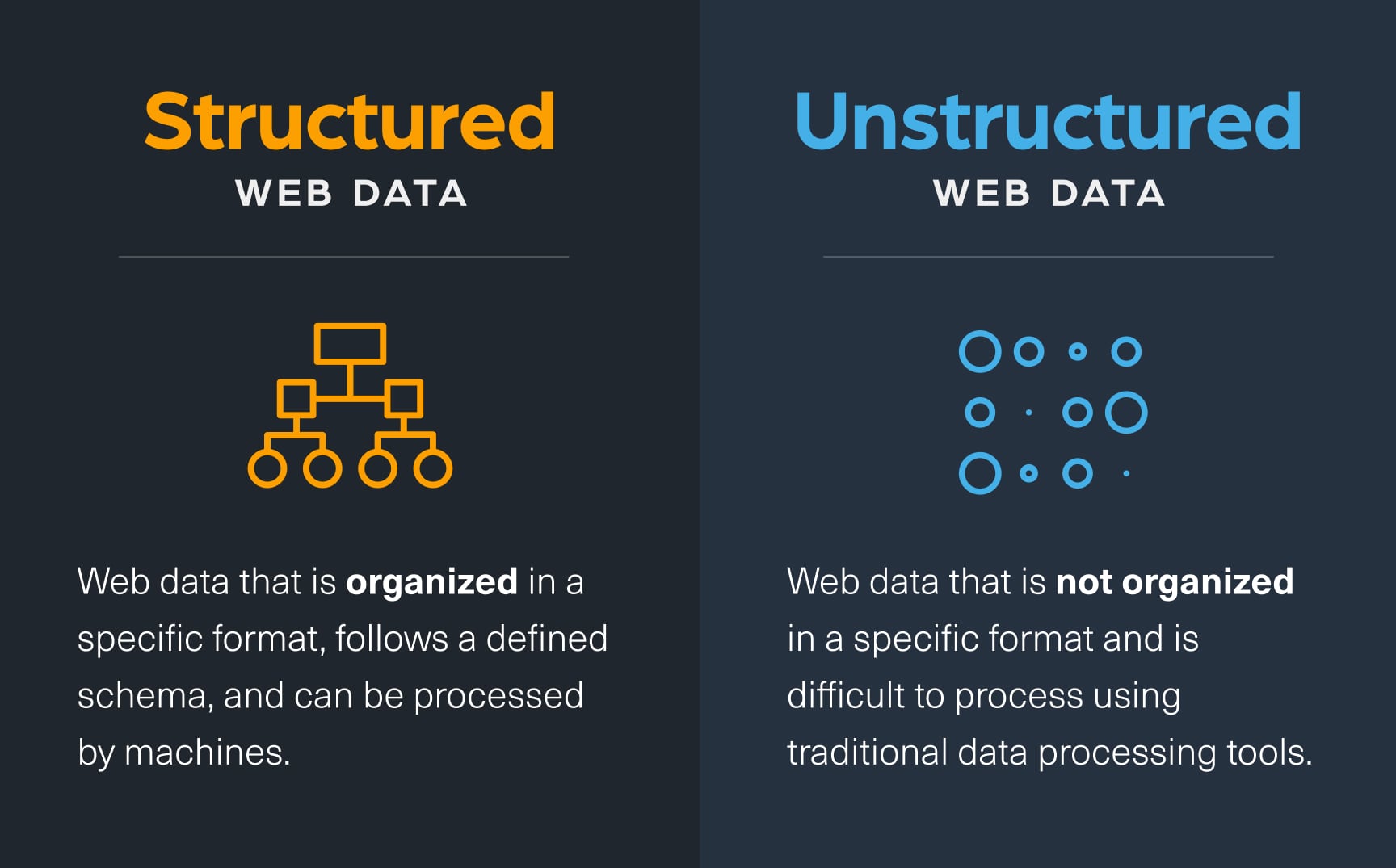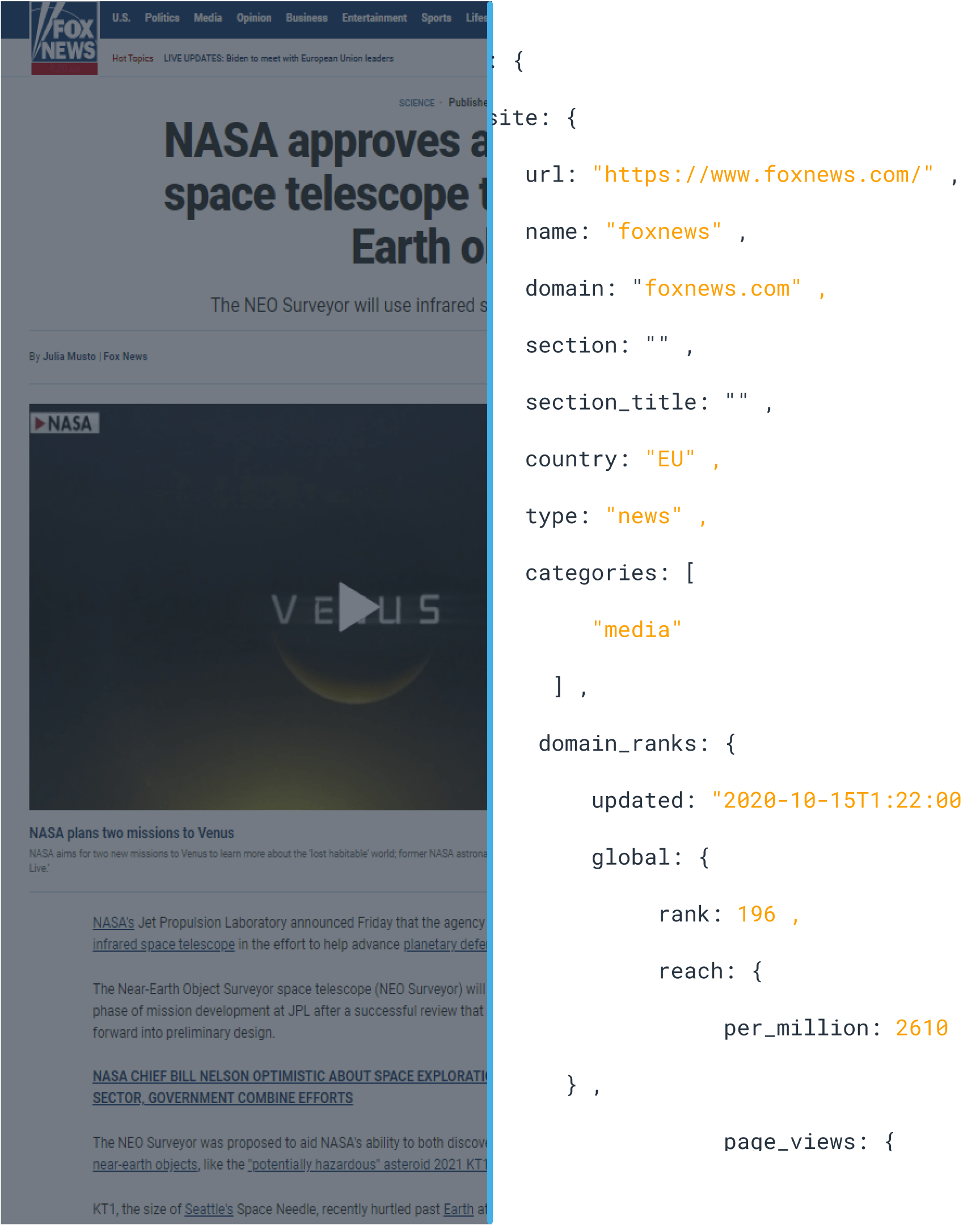The big data analytics market is expected to reach $103 billion in 2023. By 2030, experts predict the revenue of the entire big data market to reach $473.6 billion. These numbers confirm what most of us experience daily and also the costly consequences of it: the increasing need for businesses to turn data into insights.
Web data is the main source of information for companies, institutions, and organizations of all types. The good news is, tools crawling the open web and automating data collection and analysis are getting more efficient. The bad news is not only the amount of data on the public web is growing but also its complexity. Companies face new challenges and need to explore options for processing data. The biggest question is what will help you stay ahead of the curve – unstructured or structured web data?
In this article, we’ll explore the differences between structured and unstructured web data and their advantages. You’ll understand why they serve different purposes and why structuring data is crucial for gaining scalable insights.
How do you define web data?
Web data is the entire scope of content gathered on the internet, including open web data, dark web data, and deep web data. It’s widely understood that open web data refers to publicly available data such as news, blogs, and official websites. Dark and deep web data, on the other hand, is less accessible and its significance is often less understood.
Darknet refers to the data from hidden networks that can only be reached with specific browsers. This includes leaked and stolen information from sites often used for illegal activity. Deep web data refers to data from sites that traditional search engines do not index, or data that lives on password-protected sites such as Telegram. Learn more about it in our Web Data 101 here.
2 main types of web data – structured vs. unstructured
Structured web data is data in a standardized format, suitable for machine reading. Unstructured web data refers to any raw data on the web, regardless of its format or type.

80-90% of the data generated today on the web is unstructured. If you find managing unstructured data somewhat challenging, you are not alone. 95% of businesses feel the same.
What is structured web data and where is it useful?
Structured data follows a predefined data model and is formatted to a fixed structure. This type of data is easily searchable and decipherable by machine learning algorithms and does not require expert skills.
Below is a simple example of structured data as it appears in a feed generated by Webz.io’s News API:

The advantages of structured web data are:
- It can easily be processed and analyzed
- It can be filtered, segmented, re-organized, etc
- It is accessible to many tools including machine learning tools
- It requires low storage space and cost
These are only some reasons that make a range of companies, from media intelligence giants like Mention to risk and threat intelligence leaders like Signal turn to Webz.io for structured web data feeds.
The 3 methods to collect and structure web data
There are many reasons companies need to collect web data. Market research and monitoring, risk assessment and threat intelligence, and website and competitor tracking are only a few common use cases.
In some industries and for some business needs, ad-hoc scraping tools crawling the public web are sufficient. However, these are not customizable and don’t scale well. Therefore, they aren’t sufficient for larger enterprises or companies with specific needs for data accuracy. Often such businesses opt for building their own DYI web crawlers, which is costly and time-consuming.
The most efficient way for large organizations with high data requirements is DaaS (Data-as-a-Service) providers. They deliver structured web data packages at scale.
Top-tier web data providers like Webz.io offer standardized web data APIs that integrate with an automated analytics system. Data gets fed into your tool using JSON, XML, or CSV format for simplified insights generation.
What is unstructured web data and how can it be used?
Gartner defines unstructured data as ‘content that does not conform to a specific, predefined data model’. It is generally human-oriented and can’t be processed or analyzed by conventional methods. That’s why it requires the expertise of a data scientist to gain useful insights.
Unstructured data refers to all types of media and content in their original, raw form. We are talking about anything from news articles and podcasts to historical government records.
The advantages of unstructured web data are:
- It offers a large variety of usage options for data scientists
- It can be collected quickly in large volumes
- It is retrievable in its original format
Tools to process and analyze unstructured web data
Analyzing unstructured web data usually serves a different purpose. Companies may want to provide quick automated responses to users engaging on their website or platform. This includes applications such as customer service chatbots or social listening. Related tools use NLP and models to identify meaning or terms.
However, to generate actionable insights, such as the sentiment surrounding a specific topic comparing the extent of news coverage in different regions, the data needs to undergo standardization.
Overview of the differences between structured and unstructured web data
| Structured Web Data | Unstructured Web Data |
| Standardized | Raw |
| Pre-defined data model | No common format |
| Machine-readable | Not machine-readable |
| Less data volume – focused on what’s relevant | Larger volume – noisy and messy |
| Accurate | Vague |
| Requires low storage space and cost | Takes up huge storage |
| Requires limited data analysis expertise | Requires advanced data analysis expertise |
| Requires limited additional crawling capabilities | Requires advanced additional crawling capabilities |
Making the best of structured and unstructured web data
Working with unstructured web data has its uses. However, to run queries and analyze data at scale, you need to convert web data into a structure based on coherent data points so your tools can read and parse. Structured web data is vital for generating strategically and statistically valuable insights.
Converting unstructured web data into an organized set of data is time-consuming, costly, and requires expert knowledge. Webz.io delivers structured web data feeds in real time and allows you to generate highly accurate, valuable insights based on the entire WWW.
To learn more about how structured web data can help you gain better insights at scale – talk to one of our data experts.




